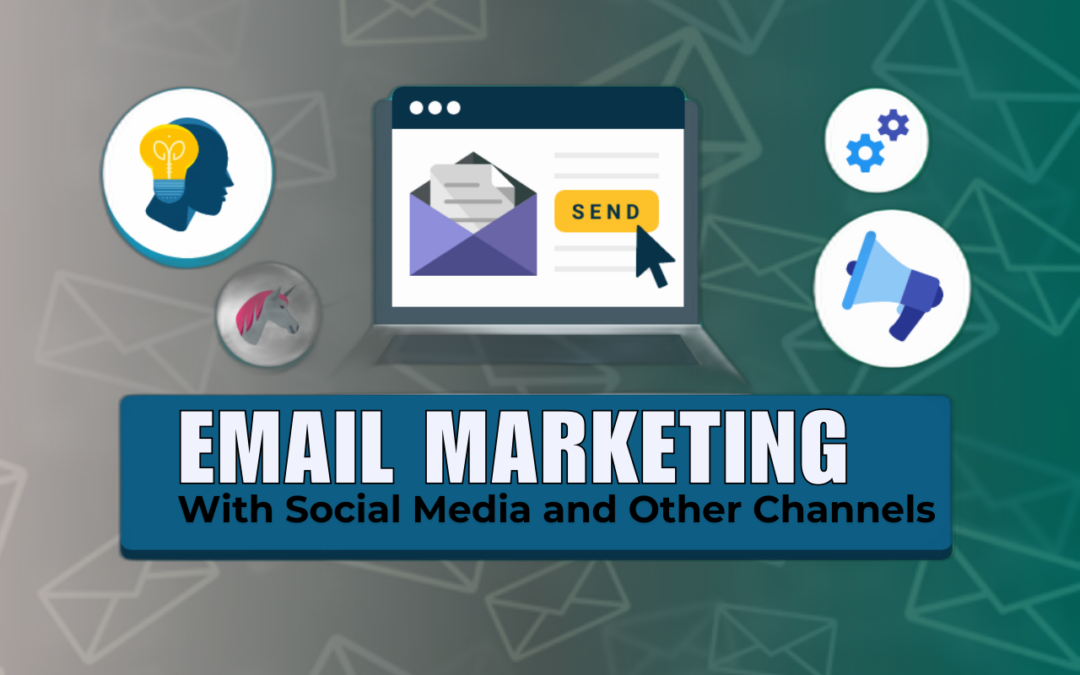In today’s multi-channel marketing landscape, brands must leverage various platforms to stay competitive. Email marketing remains one of the most effective digital marketing channels, but to maximize its potential, it’s essential to integrate it seamlessly with other marketing channels, especially social media. By doing so, businesses can create more cohesive customer journeys, increase engagement, and drive better results.
But how can you integrate email marketing with social media and other channels effectively? In this article, we’ll explore key strategies, share helpful insights, and highlight facts and statistics that demonstrate the power of integrated marketing.
1. The Importance of Integration Across Channels
First, let’s examine why integrating email marketing with social media and other channels is crucial.
- Increased Reach and Engagement: According to a McKinsey & Company report, companies with strong omnichannel customer engagement see a 91% higher customer retention rate and a 20% higher annual revenue compared to those with weak engagement strategies. By using multiple touchpoints such as email and social media, brands can increase visibility and foster deeper engagement with their audience.
- Consistency in Messaging: Customers expect a consistent brand experience, whether they’re browsing your website, receiving an email, or engaging with you on social media. In fact, consistent brand presentation across all platforms can increase revenue by 23% (source: Forbes). A seamless experience helps build trust and encourages users to engage more frequently.
- Better Data Insights: Integrated marketing allows for a more unified view of your customer data. With tools like Google Analytics and social media analytics, you can gather insights from multiple sources, helping you create targeted, personalized campaigns.
2. Building a Cohesive Strategy: Linking Email Marketing with Social Media
Integrating email marketing with social media is one of the most straightforward and effective strategies. Here’s how you can do it:
a) Cross-promote between Channels
Promoting your email list on social media is one of the easiest ways to grow your email database. Add email sign-up forms or call-to-action (CTA) buttons to your social media profiles, stories, and posts. For example, Instagram Stories or Facebook posts can feature a link to your landing page, prompting followers to subscribe to your newsletter.
- Stat: 80% of marketers say social media efforts increase traffic to their websites, and 58% of social media usersreport using platforms to discover new brands (source: Sprout Social).
Similarly, email campaigns can encourage subscribers to follow your social media accounts for real-time updates, exclusive offers, or more engaging content. This dual approach can create a community-driven marketing experience that keeps your audience engaged on multiple fronts.
b) Share Social Proof in Emails
Integrating social media content into your email marketing campaigns adds authenticity and social proof. By showcasing user-generated content, customer reviews, or testimonials from your social media followers, you can build trust with your email audience.
For instance, featuring Instagram photos of customers using your product or highlighting a popular Facebook post in your email can create a sense of belonging and validation for your subscribers.
- Stat: According to BrightLocal, 79% of people trust online reviews as much as personal recommendations. By integrating user-generated content into your emails, you’re providing your audience with relatable, authentic content that builds trust and engagement.
c) Leverage Social Sharing Buttons in Emails
Make it easy for your subscribers to share your email content on their social media platforms. Include social sharing buttons in your emails, and encourage recipients to share offers, blog posts, or product recommendations with their networks.
The more your content is shared, the greater your reach will be. When recipients share your email on social media, they help extend your message to a broader audience, driving both new traffic and increasing brand awareness.
- Stat: 77% of consumers are more likely to purchase from a brand if they have shared a post about that brand on social media (source: AdRoll).
3. Integrating Email Marketing with Other Channels
While social media integration is essential, email marketing should also be coordinated with other channels like your website, paid ads, and content marketing to create a unified strategy.
a) Email + Website Integration
Your website should be fully integrated with your email marketing strategy. This means ensuring that email campaigns drive traffic to relevant landing pages on your site, and that your website includes opportunities to sign up for your email list.
- Best Practice: Use exit-intent popups on your website to capture visitors before they leave. For instance, you could offer a discount code or exclusive content in exchange for their email address, incentivizing them to subscribe before they exit your site.
- Stat: Companies that use email marketing for website conversion report an average email conversion rate of 2.4%, while those without email marketing see a significantly lower conversion rate (source: Statista).
b) Email + Paid Advertising
Paid advertising and email marketing should work in tandem to boost overall campaign effectiveness. If someone clicks on your ad but doesn’t convert, you can follow up with a targeted email campaign that encourages them to complete the desired action.
For instance, if you’re running a Facebook ad promoting a limited-time offer, you can follow up with an email that reinforces the same message and adds urgency. By aligning your paid ads and email campaigns, you create multiple touchpoints that increase the likelihood of conversion.
- Stat: According to WordStream, email marketing combined with paid search leads to a 50% higher click-through rate compared to campaigns using only one channel.
c) Integrating Email Marketing with Content Marketing
Content marketing and email marketing are natural partners. Email newsletters can serve as a distribution channel for your blog posts, videos, and other types of content. By including a CTA that directs readers to your latest blog post, whitepaper, or case study, you’re adding value to your subscribers and positioning your brand as an industry leader.
- Stat: 61% of consumers say they’re more likely to engage with content if it’s personalized based on their past interactions, meaning that integrating content marketing into email campaigns can help increase engagement (source: Content Marketing Institute).
4. Automating Email and Social Media Integration
Marketing automation tools can simplify the process of integrating email marketing with social media and other channels. Using an automation platform like HubSpot, Mailchimp, or ActiveCampaign, you can schedule and send emails based on customer behavior, segment audiences, and create targeted campaigns that align with your social media activity.
- Example: If a customer interacts with your social media post but doesn’t take further action, you can trigger a follow-up email that offers more information or a special promotion, increasing the chance of conversion.
- Stat: According to V12 Data, automated emails have an open rate of 70.5% compared to a typical email open rate of 20-30%. This makes automation a valuable tool for personalized and timely cross-channel marketing.
5. Measuring the Success of Integrated Campaigns
To ensure that your integrated marketing efforts are working, you need to measure key performance indicators (KPIs) across all channels. For email, common metrics include open rates, click-through rates, and conversion rates. For social media, metrics like engagement rates, shares, and followers are important.
- Best Practice: Use tools like Google Analytics, Facebook Insights, and email marketing analytics to track how each channel contributes to the overall customer journey.
- Stat: 72% of marketers say they can measure the ROI of their marketing activities effectively, thanks to integrated analytics (source: Salesforce).
Conclusion
Integrating email marketing with social media and other marketing channels is no longer a luxury but a necessity for modern businesses. By creating a cohesive, multi-touchpoint marketing strategy, brands can increase engagement, improve conversions, and build lasting relationships with their audience.
By following the strategies outlined in this article, leveraging automation, and tracking results, businesses can ensure they’re effectively utilizing all available channels to deliver the best possible experience to their customers. The more you integrate and streamline your marketing efforts, the more likely you are to succeed in today’s competitive landscape.











